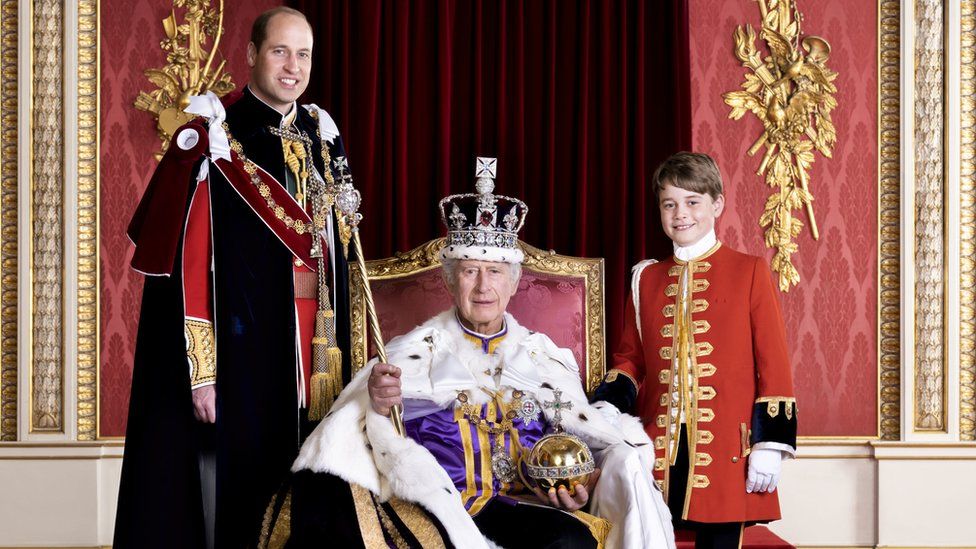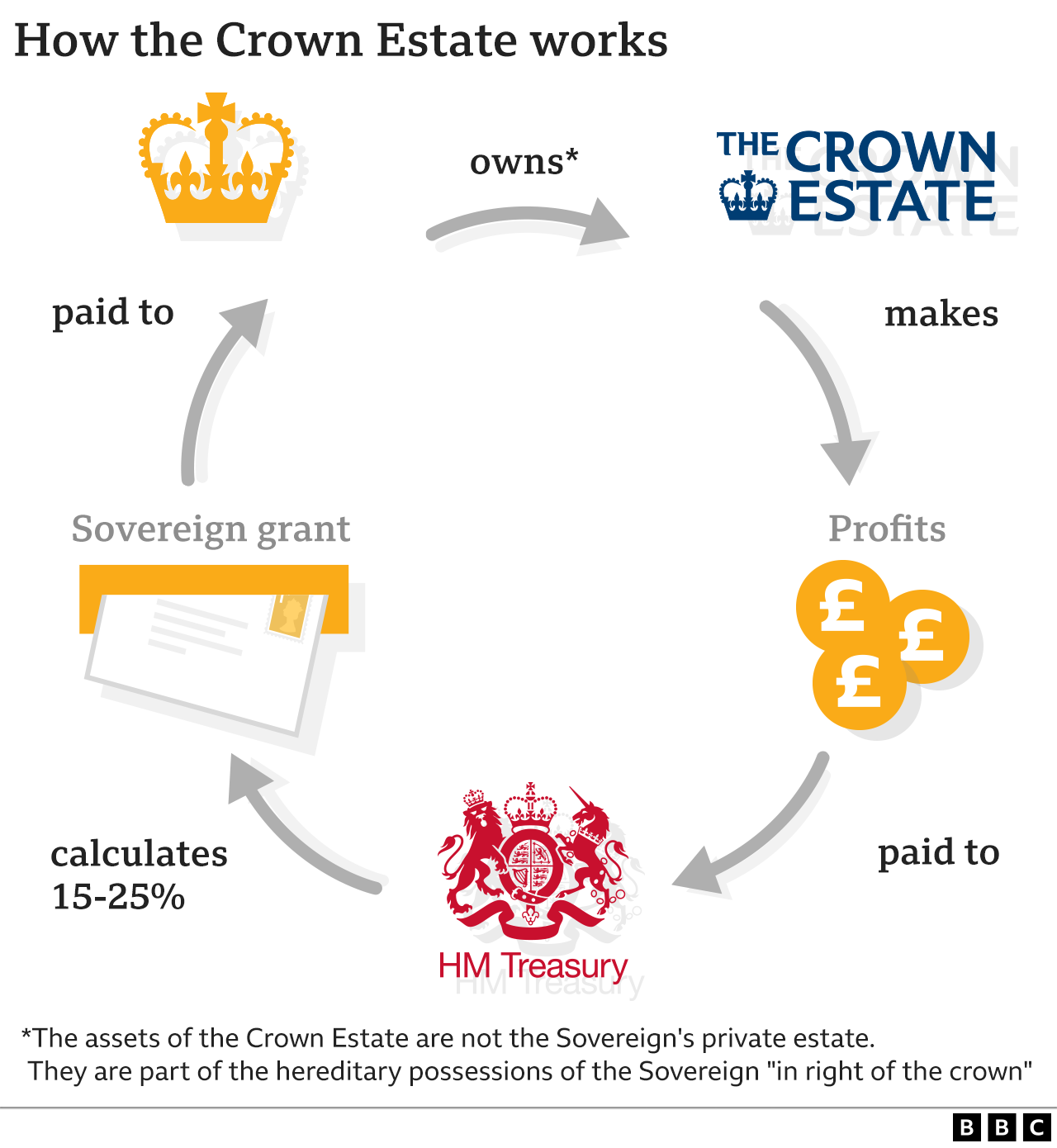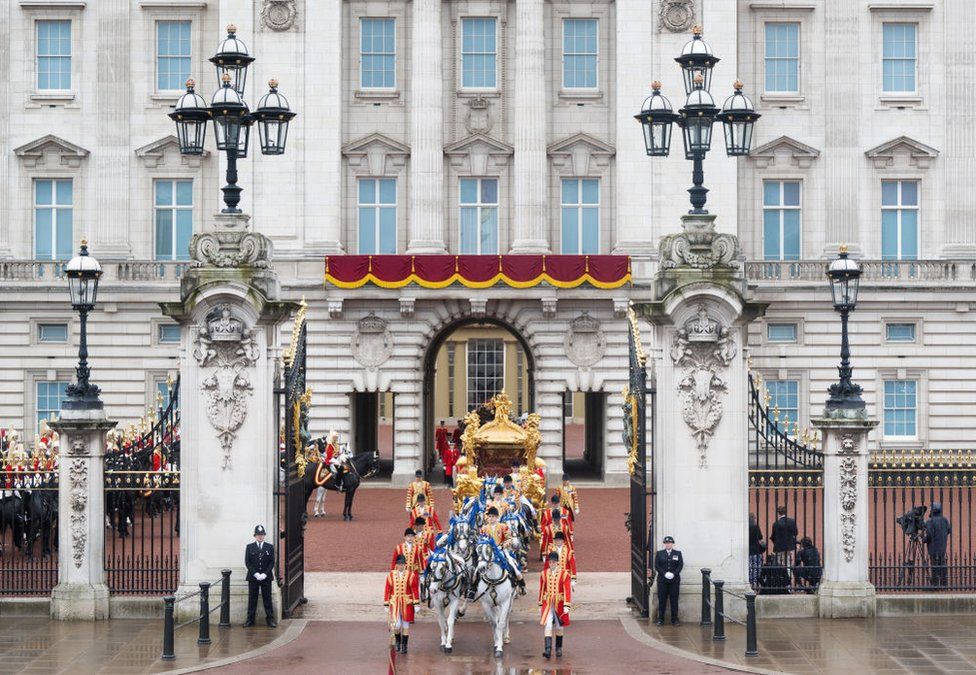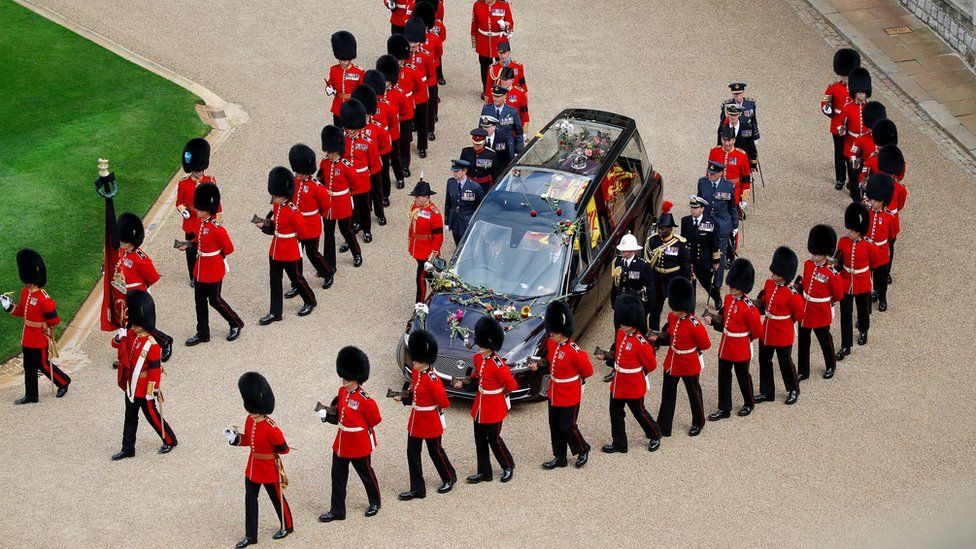Royal finances: Where does the King get his money?
The government has confirmed how much money the Royal Family received from taxpayers in 2022. …

 Image source, Hugo Burnand
Image source, Hugo BurnandThe King and his heirs Prince William and Prince George pictured in Buckingham Palace on the day of the Coronation
The government has confirmed how much money it gave to the Royal Family in 2022-23.
The taxpayer-funded settlement, known as the Sovereign Grant, is paid every year – but is not the King’s only source of income.
How much money does the Royal Family get from the taxpayer?
For 2022-2023, the Sovereign Grant was worth £86.3m, the same as in 2021-2022.
But repairs to Buckingham Palace – which is undergoing a 10-year £369m refurbishment plan – and the costs associated with King Charles succeeding Queen Elizabeth, plus higher-than-expected inflation, took total spending for the period to £107.5m.
That represents a 5% increase on the £102.4m spent the previous year.
The shortfall, with spending greater than the Sovereign Grant, meant drawing on £20.7m from reserves.
What is the Sovereign Grant spent on?
The King and other working members of the Royal Family can only use the money to pay for expenses related to their official duties.
The vast majority is spent on the upkeep of properties and staff costs.
Members of the Royal Family carried out 2,700 engagements across the UK and abroad during the year.
More than 95,000 guests attended 330 events at royal residences, including receptions, award investitures and garden parties. Buckingham Palace received more than 183,000 items of correspondence.
How is the Sovereign Grant calculated?
The amount is based on a proportion of the profits of the Crown Estate, a property business owned by the monarch but run independently. It had assets worth £16.5bn in 2022.
The Crown Estate includes almost £8bn of properties in London, including Regent Street, as well as nearly half the land along the coast of England, Wales and Northern Ireland.
It is not the King’s private property – it merely belongs to the monarch for the duration of their reign. The King cannot sell its assets or keep any profits for himself.

How is the Sovereign Grant calculated?
Normally, the amount for the monarchy is calculated as 15% of the Crown Estate profits from the previous two years. The profits go to the Treasury, but then 15% of that amount is used for the Sovereign Grant.
However, in 2017 it was agreed that this would increase to 25% for 10 years to help pay for the Buckingham Palace repairs.
Under the Sovereign Grant Act 2011, if the Crown Estate’s profits fall, the monarch still receives the same amount as the previous year, with the government making up the difference.
 Image source, Getty Images
Image source, Getty ImagesA 10-year refurbishment programme for Buckingham Palace began in 2017
In future, that percentage given to the Royals is likely to reduce, and a review is currently under way with a decision expected in the next few months.
This follows an expected increase in profits from six new offshore wind farms on the Crown Estate, worth £1bn.
King Charles has already indicated that he would want the extra money to be used for the “wider public good”.
How old is the Crown Estate?
The Crown Estate was originally the name for the lands owned by the monarch – it dates from the time of the Norman Conquest.
In 1760, King George III reached an agreement with the government to surrender his income from the Crown Estate.
In return, it was agreed that the King (and his successors) would receive a fixed annual payment – known as the Civil List.
The Sovereign Grant replaced the Civil List in 2012.
How else does the Royal Family receive money?
The King also receives money from a private estate called the Duchy of Lancaster, which is passed down from monarch to monarch.
It covers more than 18,000 hectares of land in areas such as Lancashire and Yorkshire, as well as property in central London. Worth £654m, it generates about £20m a year in profits.
 Image source, Getty Images
Image source, Getty ImagesKnaresborough Castle in Yorkshire is one of a number of historic properties owned by the Duchy of Lancaster
Whoever holds the title of Duke of Cornwall (currently Prince William) benefits from the Duchy of Cornwall.
It mainly covers land in south-west England. Worth £1bn, it generated a net surplus of £24m in 2022-23.
The King and Prince William receive the profits from the duchies personally, and can spend them as they wish. However, they are not entitled to any proceeds from the sale of any estate assets, which must be reinvested.
The monarch also owns the royal palaces (which are not part of the Crown Estate) and part of the Royal Collection of art, but these do not generate income.
Some palaces are looked after and funded by the Royal Family itself. Others – such as the Tower of London – are managed by Historic Royal Palaces, an independent charity.
The Royal Collection is also run by a charity, the Royal Collection Trust, which reinvests income received from ticket sales and retail outlets.
The Queen also earned income through properties such as Sandringham and Balmoral, which she owned personally.
In addition, some Royal Family members have private art, jewellery and stamp collections which they can sell or use to generate income as they wish.
Do members of the Royal Family pay tax?
In 1992, The Queen volunteered to pay income tax and capital gains tax on her personal income, and the King does the same.
 Image source, Getty Images
Image source, Getty ImagesQueen Elizabeth II started paying income tax and capital gains tax in 1993
The two duchies are exempt from corporation tax, but the King and the Prince of Wales voluntarily pay income tax on the revenue they generate.
They do not pay capital gains tax because they do not benefit personally from any increase in the duchies’ assets.
Members of the Royal Family pay tax on any income generated from privately-owned assets.
King Charles does not have to pay inheritance tax on the money he received when Queen Elizabeth died, under the “sovereign to sovereign” exemption agreed in 1993 by then Prime Minister John Major.
What about security and other costs?
Some argue that the true cost of the Royal Family is much greater than the size of the Sovereign Grant.
It does not cover their security arrangements, which are usually picked up by the Metropolitan Police, although the cost is not disclosed.
In May, the Treasury confirmed that Queen Elizabeth II’s funeral had cost the government an estimated £162m.
 Image source, Reuters
Image source, ReutersIt is not yet known what the King’s Coronation cost, although unofficial estimates suggest it could be between £50m and £100m.
Republic, an organisation which campaigns for an elected head of state, previously estimated that the total yearly cost of the monarchy – once security is factored in – is about £345m.
How much money does the Royal Family generate for the UK economy?
It is impossible to provide a concrete figure for the scale of the Royal Family’s contribution to the UK economy. Estimates vary considerably.
The consultancy Brand Finance argues the cost of Royal Family is eclipsed by what it contributes by boosting tourism and trade.
However, Republic questions the validity of its sums, and argues that much of the Royal Family’s assets are in fact the property of the state, and have no value because they cannot be sold.
Related Topics
Related Internet Links
The BBC is not responsible for the content of external sites.




